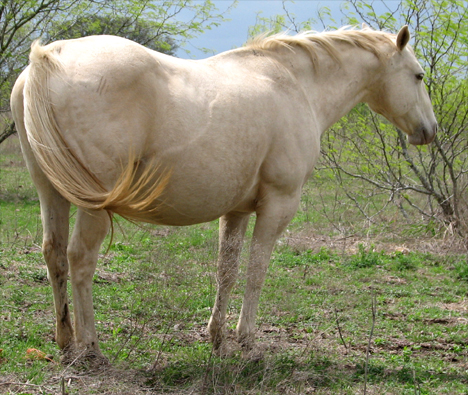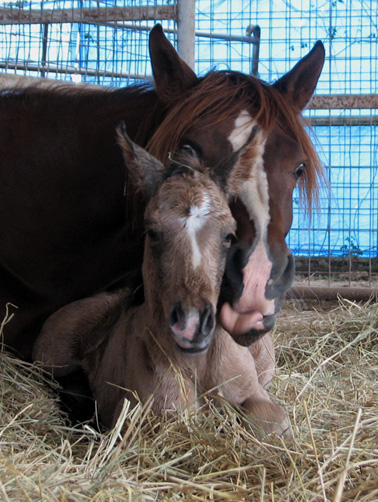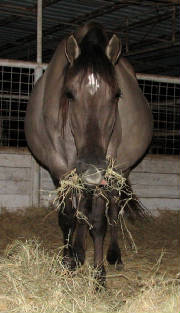Email: kigers@ranchobayo.com
rancho bayo © 2012 located in central texas usa 512.868.7638
Double click here to edit this text.
As Spring approaches and the mares enter their last trimester, they are brought out of the Wild Bunch and up near the foaling barn. Their slower step and widening bellies dictate the need for more attention as they approach foaling.
The Last Trimester
Attached to the foaling barn is a 30 acre pasture where the mares will spend the next part of their pregnancy through foaling and weaning. This pasture offers plenty of trees, a variety of forage plus planted herbs for them to choose from. They are also offered all the hay they desire plus begin getting their Whole Food Diet to balance out their ever growing needs. Their new herd includes the now-coming yearlings fillies, which will help raise the next generation as they do in the wild.
The Last Trimester
Attached to the foaling barn is a 30 acre pasture where the mares will spend the next part of their pregnancy through foaling and weaning. This pasture offers plenty of trees, a variety of forage plus planted herbs for them to choose from. They are also offered all the hay they desire plus begin getting their Whole Food Diet to balance out their ever growing needs. Their new herd includes the now-coming yearlings fillies, which will help raise the next generation as they do in the wild.

It is important that the mares come into the barn and stall where they are going to foal, a good two months before hand, so they can develop antibodies specific to that area. We have extra large foaling stalls, plus large foaling pens (30x30). We choose each foaling area depending on the individual mare and their needs. Some mares are more comfortable in the large pens, while others prefer the 12x24 stall. We have found that maiden mares do best to foal in the large pen, where they can move about more, then be moved to a more intimate stall in order to concentrate fully on their new baby.
The mares begin to come into the stalls at night and get pampered. The best hay and alfalfa is chosen for them, along with their favorite herbs and fruits. They enjoy deep sand flooring that allows them to get down comfortably and sleep well. We still prefer they go out daily with the herd up until the time they foal, unless they want to stay in.
As they get closer to foaling, we try hard to stay in tune with their needs and cater to every whim. At times, some mares like to come in earlier in the day, especially if it is getting hotter, so they can relax in front of their fans. It is always amazing to us when even the wild mares get demanding at the barn gate to come in to the barn and hang out. Each afternoon, before the mares are scheduled to come in, the sand in the stalls and pens are watered down. We have found that some of the mares prefer we wait for them so they can enjoy getting under the sprinkle of the water for a good cooling off. The mares are offered a heat lamp in cooler weather, on one side of the stall, so they can choose their own comfort level.
The mares begin to come into the stalls at night and get pampered. The best hay and alfalfa is chosen for them, along with their favorite herbs and fruits. They enjoy deep sand flooring that allows them to get down comfortably and sleep well. We still prefer they go out daily with the herd up until the time they foal, unless they want to stay in.
As they get closer to foaling, we try hard to stay in tune with their needs and cater to every whim. At times, some mares like to come in earlier in the day, especially if it is getting hotter, so they can relax in front of their fans. It is always amazing to us when even the wild mares get demanding at the barn gate to come in to the barn and hang out. Each afternoon, before the mares are scheduled to come in, the sand in the stalls and pens are watered down. We have found that some of the mares prefer we wait for them so they can enjoy getting under the sprinkle of the water for a good cooling off. The mares are offered a heat lamp in cooler weather, on one side of the stall, so they can choose their own comfort level.
Getting Close...
Once the mares get closer to foaling and begin to develop udders, we begin daily checks. We take pictures from the side, the backend and the udders for reference in the upcoming years. We check other signs, along with testing the milk for calcium levels and ph drops. All developments and changes are duly noted and written up in detail. Mares get brushed and fussed over as they desire.
As foaling time gets nearer, we may even test the mares milk twice per day and they get their tails loosely wrapped and udders cleaned. We do not keep their tails up 24/7, as that can be uncomfortable and they also need their tail for the bugs during the day. We make sure we stay on a regular schedule with feeding and finishing up for the day, so the mares have a peaceful, secure feeling about having their new foal.
Once the mares get closer to foaling and begin to develop udders, we begin daily checks. We take pictures from the side, the backend and the udders for reference in the upcoming years. We check other signs, along with testing the milk for calcium levels and ph drops. All developments and changes are duly noted and written up in detail. Mares get brushed and fussed over as they desire.
As foaling time gets nearer, we may even test the mares milk twice per day and they get their tails loosely wrapped and udders cleaned. We do not keep their tails up 24/7, as that can be uncomfortable and they also need their tail for the bugs during the day. We make sure we stay on a regular schedule with feeding and finishing up for the day, so the mares have a peaceful, secure feeling about having their new foal.




Soon we begin late night vigils in the feed room, keeping a close eye on the monitor, wired from cameras in the stalls. We are quiet and non-intrusive; no lights on in the feed room or in the barns. The glows from the heat lamps keep the stalls plenty illuminated to see the mare well and assist when it is time to foal.
As the mare begins to foal, we wait patiently for her to find a comfy spot and begin contractions. Only when the foal begins to emerge, do I enter the stall to make sure the foal is in the correct position and assist if needed. I usually break the sac, clear out the foals nose from any fluids and begin toweling off the wet coat. The mares are totally comfortable with me, so this adds no stress to them.
My goal is to make sure the foal is out and healthy and then to let the mare and foal bond as needed. It is important that this process take place naturally, in order for the foal to learn bonding and to become a well adjusted adult horse. Foals that are overly handled or even held down and "imprinted", usually end up with connection issues later in life. Some develop a block and leeriness toward other horses and humans; and some become very unconfident and cling to the mare for protection.
Foals need to get up and get nursing. They need to get those legs working and begin to figure things out. Disruption in this process is not healthy for the foal or the mare. I've seen ill effect many times of foals that are held down at birth and "desensitized"...
As the mare begins to foal, we wait patiently for her to find a comfy spot and begin contractions. Only when the foal begins to emerge, do I enter the stall to make sure the foal is in the correct position and assist if needed. I usually break the sac, clear out the foals nose from any fluids and begin toweling off the wet coat. The mares are totally comfortable with me, so this adds no stress to them.
My goal is to make sure the foal is out and healthy and then to let the mare and foal bond as needed. It is important that this process take place naturally, in order for the foal to learn bonding and to become a well adjusted adult horse. Foals that are overly handled or even held down and "imprinted", usually end up with connection issues later in life. Some develop a block and leeriness toward other horses and humans; and some become very unconfident and cling to the mare for protection.
Foals need to get up and get nursing. They need to get those legs working and begin to figure things out. Disruption in this process is not healthy for the foal or the mare. I've seen ill effect many times of foals that are held down at birth and "desensitized"...
We stay with the pair until both mare and foal are up, the placenta is passed and inspected, the foal has nursed a few times, pooped comfortably at least once and gotten up and down a couple times on its own. We quietly observe and only help out when needed.
The most important aspect is that the mare and foal bond at this point. This is of the utmost importance for the future development of the foal and the ability for that foal to form close relationships with humans later in life. We do not make pets out of our foals and respect that a horse needs to be a horse first and a human partner later. This begins from day one, allows the horse to develop naturally and honestly makes a more stable, well adjusted horse in the future.
The most important aspect is that the mare and foal bond at this point. This is of the utmost importance for the future development of the foal and the ability for that foal to form close relationships with humans later in life. We do not make pets out of our foals and respect that a horse needs to be a horse first and a human partner later. This begins from day one, allows the horse to develop naturally and honestly makes a more stable, well adjusted horse in the future.